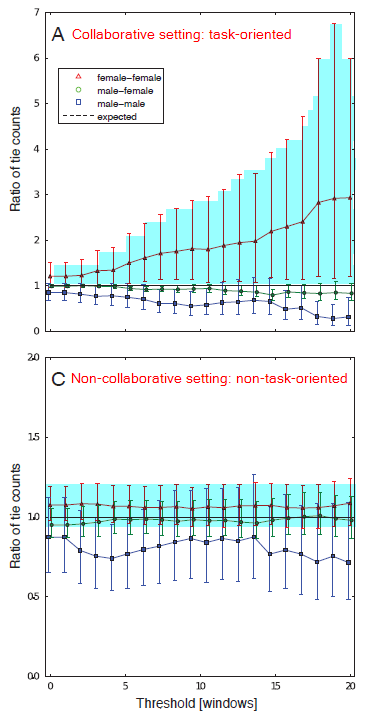Using sociometers to quantify social interaction patterns
Note: this is not related to finance, but a fun study we found while perusing economic and behavioral psychology journals.
- Onnela, Waber, Pentland, and Lazer.
- A version of the paper can be found here
- Want a summary of academic papers with alpha? Check out our Academic Research Recap Category
Abstract:
Research on human social interactions has traditionally relied on self-reports. Despite their widespread use, self-reported accounts of behaviour are prone to biases and necessarily reduce the range of behaviours, and the number of subjects, that may be studied simultaneously. The development of ever smaller sensors makes it possible to study group-level human behaviour in naturalistic settings outside research laboratories. We used such sensors, sociometers, to examine gender, talkativeness and interaction style in two different contexts. Here, we find that in the collaborative context, women were much more likely to be physically proximate to other women and were also significantly more talkative than men, especially in small groups. In contrast, there were no gender-based differences in the non-collaborative setting. Our results highlight the importance of objective measurement in the study of human behaviour, here enabling us to discern context specific, gender-based differences in interaction style.
Alpha Highlight:
Do women sit around and gossip in the cafeteria, while men only talk when it matters?
Are these stereotypes true or do we (i.e., men) suffer from availability bias, overconfidence, group think, and a whole slew of additional biases?
The authors in this paper examine the gender differences in talkativeness using electronic instrumentation (Sociometers) rather than human observers (surveys and questionnaires). To be specific, “Sociometers” are wearable devices that use high-frequency radio transmitter to collect detailed information on social interactions. Using machine can help improve accuracy (Check “Machine vs. Experts” category to read more articles).
The paper designs two settings and assesses participants’ communication behaviors:
- Setting 1 — Collaborative setting: 79 students (42 males, 37 females) were required to process a large quantity of sophisticated readings and they are allowed to communicate to each other. The performance of the students in the exercise would affect their final course grades.
- Setting 2 — Non-collaborative setting: 54 co-located employees (16 males and 38 females) were studied during 12 one-hour lunch breaks (typically in a cafeteria and in small groups).
In panel A below, there is evidence that women are more talkative than men in collaborative settings where results matter.
In panel C, there is no evidence for gender-based differences in talkativeness where results don’t matter.

The results are hypothetical results and are NOT an indicator of future results and do NOT represent returns that any investor actually attained. Indexes are unmanaged, do not reflect management or trading fees, and one cannot invest directly in an index. Additional information regarding the construction of these results is available upon request.
Overall, the evidence shows no support for the traditional stereotype that women gossip around the water cooler all day while the men do the “important” talking. In fact, the evidence suggests that women engage in conversation when it actually matters–which is probably the optimal thing to do if you want to get things done.
Another reason why women will eventually rule the world (if they don’t already)…
About the Author: Wesley Gray, PhD
—
Important Disclosures
For informational and educational purposes only and should not be construed as specific investment, accounting, legal, or tax advice. Certain information is deemed to be reliable, but its accuracy and completeness cannot be guaranteed. Third party information may become outdated or otherwise superseded without notice. Neither the Securities and Exchange Commission (SEC) nor any other federal or state agency has approved, determined the accuracy, or confirmed the adequacy of this article.
The views and opinions expressed herein are those of the author and do not necessarily reflect the views of Alpha Architect, its affiliates or its employees. Our full disclosures are available here. Definitions of common statistics used in our analysis are available here (towards the bottom).
Join thousands of other readers and subscribe to our blog.

